Heel & Toe Pedal placement??
#1
Racer


Thread Starter
Member Since: Jul 2011
Location: Wellington FL
Posts: 370
Likes: 0
Received 0 Likes
on
0 Posts
For those who have altered the gas pedal to ease the heel and toe action, please comment on what you did. I've extended the gas pedal closer to the brake, but still seems too far, and too low. Comments?
#3
I'm learning heel/toe and my feet are a bit narrow to span the distance from the edge of the brake pedal to the edge of the gas pedal.
I plan to wait until after my first track day to see how it feels. I'm thinking that when I depress the brake HARD going into corners it'll feel completely different than it does with street driving (even if I try to duplicate a track situation on street it's not likely it'll feel the same).
After I get some laps in with hard braking I figure I'll really have the feel and then can alter as needed. I don't want to alter it now, get used to it over the next couple months for street driving, and then find on the track it feels weird or wrong cause I altered it without the understanding of what threshold braking feels like.
Any advice on my plan?
Thanks
I plan to wait until after my first track day to see how it feels. I'm thinking that when I depress the brake HARD going into corners it'll feel completely different than it does with street driving (even if I try to duplicate a track situation on street it's not likely it'll feel the same).
After I get some laps in with hard braking I figure I'll really have the feel and then can alter as needed. I don't want to alter it now, get used to it over the next couple months for street driving, and then find on the track it feels weird or wrong cause I altered it without the understanding of what threshold braking feels like.
Any advice on my plan?
Thanks

#4
You are on the right track, but you can figure it out in your garage. Just press the brake as hard as you can and you will see where it ends up relative to the position of the throttle. Throw in over heated brakes and it may go even lower. I have yet to drive a car with factory pedals in which the brake pedal was not too low at full brake. On the track if you get the the point where you are turning good lap times you will find that you will be using maximum braking into some corners.
In my case that meant the brake pedal pad was lower than the throttle. Raising it made heel/toe a whole lot easier.
You need to do whatever works for you.
I have driven a car where the brake was too low at the track and the temporary quick fix ended up placing the brake a bit too high for conventional heel/toe. The quick solution was to apply the brake with my heel and blip the throttle with my toe.
In my case that meant the brake pedal pad was lower than the throttle. Raising it made heel/toe a whole lot easier.
You need to do whatever works for you.
I have driven a car where the brake was too low at the track and the temporary quick fix ended up placing the brake a bit too high for conventional heel/toe. The quick solution was to apply the brake with my heel and blip the throttle with my toe.
#5
You are on the right track, but you can figure it out in your garage. Just press the brake as hard as you can and you will see where it ends up relative to the position of the throttle. Throw in over heated brakes and it may go even lower. I have yet to drive a car with factory pedals in which the brake pedal was not too low at full brake. On the track if you get the the point where you are turning good lap times you will find that you will be using maximum braking into some corners.
In my case that meant the brake pedal pad was lower than the throttle. Raising it made heel/toe a whole lot easier.
You need to do whatever works for you.
I have driven a car where the brake was too low at the track and the temporary quick fix ended up placing the brake a bit too high for conventional heel/toe. The quick solution was to apply the brake with my heel and blip the throttle with my toe.
In my case that meant the brake pedal pad was lower than the throttle. Raising it made heel/toe a whole lot easier.
You need to do whatever works for you.
I have driven a car where the brake was too low at the track and the temporary quick fix ended up placing the brake a bit too high for conventional heel/toe. The quick solution was to apply the brake with my heel and blip the throttle with my toe.
I tried the "braking with heel and blip throttle with toe". Maybe I need hundreds more shifts before I can say whether it could work - but it was a very awkward foot position, and I felt that I need my heel planted in order to modulate pressure on the pedals. With half my foot on the brake and the other half on the throttle I had nothing to "steady" against, and felt as though there was too much potential for me to be too hard or soft on one or the other. Too difficult to control.
With my heel planted on the floor I found it easier to "heel/toe" with the ball of my foot (left edge on brake - right edge on throttle).
My concern is slipping OFF the brake at a critical moment - in which case I'd imagine heel/toe goes out the window and you get hard on the brakes and write off that corner, and maybe the lap - and just try to stay on the track.
Good advice about pressing down really hard (just parked in the garage). That will give me some idea of what I'm dealing with.
#6
I'd bet you are trying it on the street or similar scenario where you really don't need much stopping power. Power brakes are harder to modulate than real race brake setups with no boost and properly sized hydraulics that use minimal pedal travel. Especially on the street. They are assisted too much and you most likely tend to input too much brake. On the track going into a slow corner with a very fast approach you will want to use your leg muscles as opposed to your calf muscles. With that you will find that you will not be keeping your heel much on the floor.
On the race track I actually use my left foot to press the brakes. The only time I use my right foot is when I have to down shift and match rpms. On cars with dog ring transmissions I never use my right foot for anything but the throttle. I find it much easier to dedicate my left foot to slowing down and my right foot to the throttle. No need for heel/toe in that situation.
On the race track I actually use my left foot to press the brakes. The only time I use my right foot is when I have to down shift and match rpms. On cars with dog ring transmissions I never use my right foot for anything but the throttle. I find it much easier to dedicate my left foot to slowing down and my right foot to the throttle. No need for heel/toe in that situation.
#7
Safety Car


My heel/toe has evolved into mostly ball of foot on brake and side of foot on gas. Not sure if the gas pedal was wider it would make it easier for a more conventional exection. Seems like in one of Chuck Hawks classes we did a drill where we heel/toe during downshift, then while still braking, slide left foot onto brake and finish braking while right foot moves to gas. All this without changing the balance of the car. It works pretty good at VIR in a couple of places. I have found the brake pedal to be pretty narrow for that. I picked up a set of al brake and gas pedals but haven't installed them yet. Planning on doing just one at a time to see what difference each makes. Even without hardcore braking it is still pretty good practice executing it on the street including left foot braking.
#8
Melting Slicks


I just discovered that the type of shoes I wear makes a big difference. I've been using Bell driving shoes that resemble boots and I recently bought new sparcos which are the narrow slipper looking type because the SFI tag fell off my Bell shoes. I could not heel/toe with the sparcos during my first race with them. My technique evolved with the wider bell shoes so I will just keep using them and keep the sparcos to pass tech for now  .
.
 .
.
#9
Melting Slicks


I just discovered that the type of shoes I wear makes a big difference. I've been using Bell driving shoes that resemble boots and I recently bought new sparcos which are the narrow slipper looking type because the SFI tag fell off my Bell shoes. I could not heel/toe with the sparcos during my first race with them. My technique evolved with the wider bell shoes so I will just keep using them and keep the sparcos to pass tech for now  .
.
 .
.
#10
Safety Car


Better to but a cover/shim on the brake so that it extends toward the gas. I actually made shims for mine so that I can change the effective pedal height between sessions if need be. Using SRF in the brakes helps with keeping the pedal height consistent all weekend.
#12
Safety Car


My heel/toe has evolved into mostly ball of foot on brake and side of foot on gas. Not sure if the gas pedal was wider it would make it easier for a more conventional exection. Seems like in one of Chuck Hawks classes we did a drill where we heel/toe during downshift, then while still braking, slide left foot onto brake and finish braking while right foot moves to gas. All this without changing the balance of the car. It works pretty good at VIR in a couple of places. I have found the brake pedal to be pretty narrow for that. I picked up a set of al brake and gas pedals but haven't installed them yet. Planning on doing just one at a time to see what difference each makes. Even without hardcore braking it is still pretty good practice executing it on the street including left foot braking.
Note the wide brake pedal on Said's car. he always has a wide brake pedal on his cars. He uses both feet on the brake pedal at the same time. I don't understand why left foot braking is not emphasized in comp driving even if is simply to check if you do actually have brakes before you need them.
It is easy to widen your Zs brake pedal on both sides and change its height if you know a good fabricator. Don't mess with the gas pedal's position. That fly by wire stuff is sensitive.
Shoes are important but the souls of the shoes are more important. The pedals must have no rubber on them only your shoes. Replace your shoes often. They must slip and grip easily. Simpson shoes have perfect rubber. Keep pedals really clean.
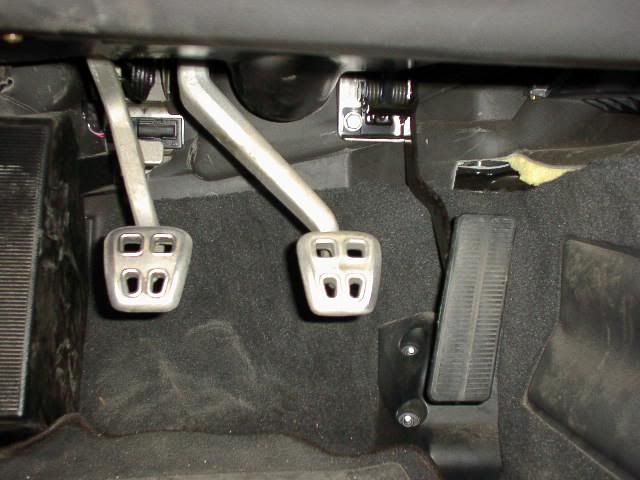
Stock Z06
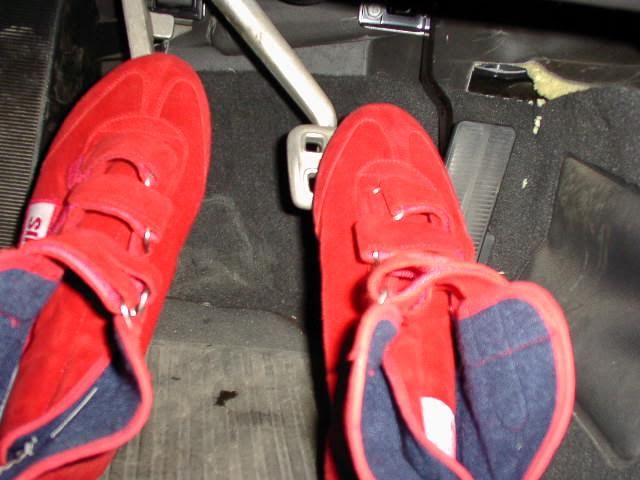
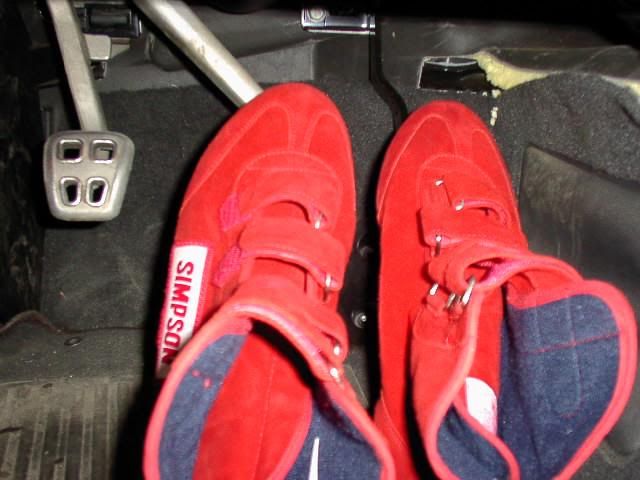
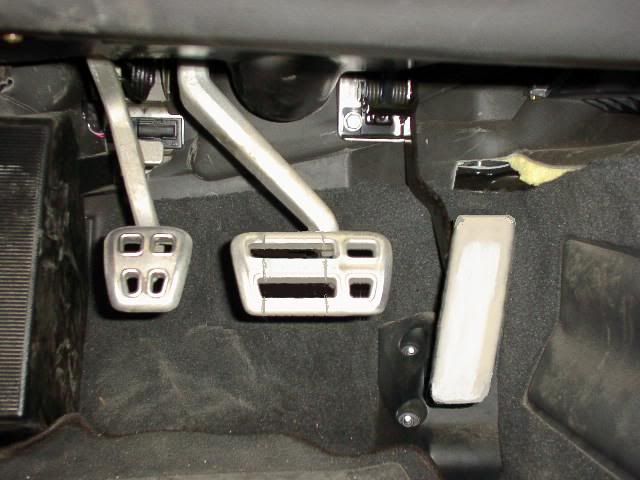
Widened brake pedal both sides. Rubber removed off gas.
http://www.youtube.com/watch?v=TUodMtqk7mo The travel on these pedals is way too much and an hour of this will kill your legs.
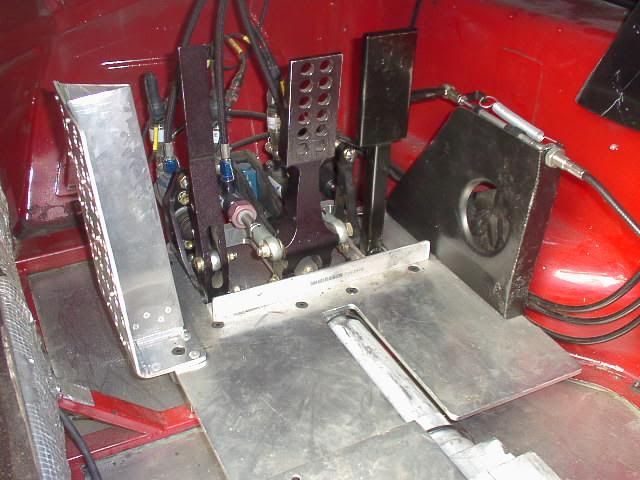
This is LG Motorsports lay out. Driver's feet slide on the floor and with floor mounted pedals and a very low seat requires foot and ankle movement which is better than leg movement for fatigue.
Taller drivers may have different techniques to shorter ones. It is important to take some time to sort this out before you go racing. The lower your legs the better.
#13
Safety Car


I'd bet you are trying it on the street or similar scenario where you really don't need much stopping power. Power brakes are harder to modulate than real race brake setups with no boost and properly sized hydraulics that use minimal pedal travel. Especially on the street. They are assisted too much and you most likely tend to input too much brake. On the track going into a slow corner with a very fast approach you will want to use your leg muscles as opposed to your calf muscles. With that you will find that you will not be keeping your heel much on the floor.
On the race track I actually use my left foot to press the brakes. The only time I use my right foot is when I have to down shift and match rpms. On cars with dog ring transmissions I never use my right foot for anything but the throttle. I find it much easier to dedicate my left foot to slowing down and my right foot to the throttle. No need for heel/toe in that situation.
On the race track I actually use my left foot to press the brakes. The only time I use my right foot is when I have to down shift and match rpms. On cars with dog ring transmissions I never use my right foot for anything but the throttle. I find it much easier to dedicate my left foot to slowing down and my right foot to the throttle. No need for heel/toe in that situation.
I've built a few pedal boxes in my time and the task of getting a scratch built car's brakes to work right is the most difficult part of car building. I'm no Adrian Newey.

No power brakes here which really complicates line pressure bias and pedal effort. Travel is almost impossible to get right..
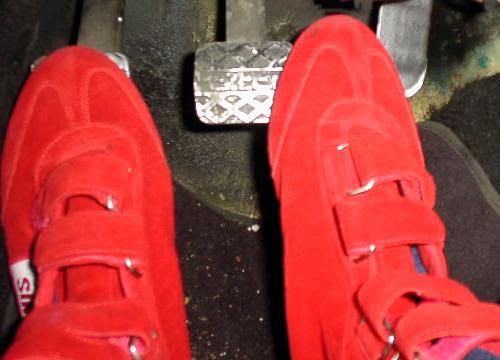
The Tilten set up is just too narrow. I have 9 1/2 shoes.

I switched to a Toyota Tacoma booster master and my own pedal box. Works perfect. After owning two aerobatic aircraft, I got the idea of having the clutch and gas pedals as far apart as possible with Boris' wide brake pedal in-between. A dead pedal left of the clutch also reduces fatigue. This stance and reduced movement is for torso balance and reduced effort on the part of the driver.

I would have made this LG box a lot wider. Depends on how much money you want to spend on your Vette. You would think that Corvette would do a better job on their pedals especially on a Z06 and ZR1.
How difficult would it be to have a P GT2 or F458 set up? These are some of the refinements I would like to see on the C7.
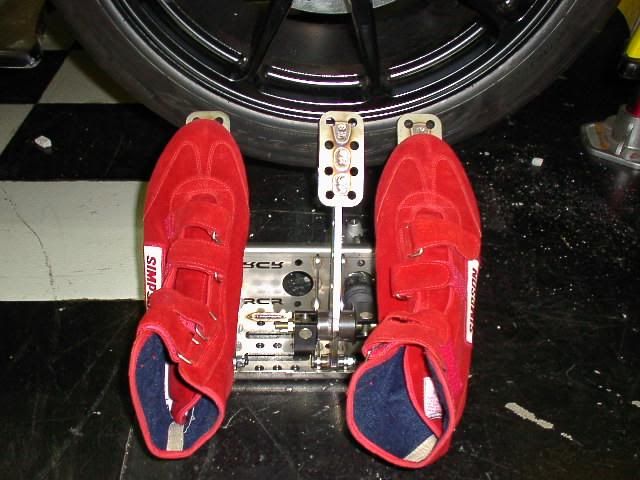
This arrangement is from RCR and is fully adjustable.
#14
The Z06 is my first manual transmission car (for any purpose) so I'll have a lot of learning & adjustments when I get on track. (I've known how to drive a manual for many years and have the chance every so often but owning one is SO much more FUN
 !)
!)The suggestion of making the brake pedal wider (top photo), and removing rubber from the throttle are interesting.
On the alterations to that brake pedal - safe to say the OEM pedal was split, and then a piece inserted in the center, and then all welded together? Any concerns about strength of this mod? Under threshold braking - any chance of something cracking and coming apart? That would be my main worry with that particular method. But maybe it's just as strong as a solid piece. I don't know much about the technical side of attaching metal to metal.
#15
Safety Car


This (LG ^)
The Z06 is my first manual transmission car (for any purpose) so I'll have a lot of learning & adjustments when I get on track. (I've known how to drive a manual for many years and have the chance every so often but owning one is SO much more FUN !)
!)
The suggestion of making the brake pedal wider (top photo), and removing rubber from the throttle are interesting.
On the alterations to that brake pedal - safe to say the OEM pedal was split, and then a piece inserted in the center, and then all welded together? Any concerns about strength of this mod? Under threshold braking - any chance of something cracking and coming apart? That would be my main worry with that particular method. But maybe it's just as strong as a solid piece. I don't know much about the technical side of attaching metal to metal.
The Z06 is my first manual transmission car (for any purpose) so I'll have a lot of learning & adjustments when I get on track. (I've known how to drive a manual for many years and have the chance every so often but owning one is SO much more FUN
 !)
!)The suggestion of making the brake pedal wider (top photo), and removing rubber from the throttle are interesting.
On the alterations to that brake pedal - safe to say the OEM pedal was split, and then a piece inserted in the center, and then all welded together? Any concerns about strength of this mod? Under threshold braking - any chance of something cracking and coming apart? That would be my main worry with that particular method. But maybe it's just as strong as a solid piece. I don't know much about the technical side of attaching metal to metal.
It will take about two years of reinforced conscience learning for the pedal dance to become a subconscious action depending on previous learning and aptitude. It helps if you have a thorough understanding of what you are doing and for what reasons.
http://www.youtube.com/watch?v=C4Qi7dlYKx0 This vid shows a lot of foot activity done in treacherous conditions. It is an art form. The left foot touch on the brake is to clear water off the rotor and to check if there are brakes in the first place.
You are at max throttle before entering a corner, do a left foot brake check and then brake hard. It is quicker than lifting your foot off the gas and braking with your right foot. You then can heel and toe for selecting lower gears after slipping your left foot onto the clutch.. This is the time when you need the wide pedal but most do it with a narrow brake pedal. Only Boris and me think it important.
With a Vette, there are many areas on the track that you don't have to shift. You can use two foot driving during these sections.
You don't have to double de clutch any more because modern syncros don't require it and also they can get damaged if you do. You can see McConville do it once.
There are some of us old farts who have been double clutching for years and it is sometimes difficult to unlearn things. There was a time that I couldn't change gears if the engine didn't blip. My brain engaged a lock out even though no such mechanism exists in the transmission. The clutch must be in or out and nothing in-between and yet smooth. Some lunis shove the gear lever into a lower gear and let the clutch do all the engine/tranny synchro work. This severely reduces clutch life and causes high reversal loads in the drive train not to talk about upsetting the car.
Sometimes you use left foot braking for other things like stabilizing transitions and load transfer augmentation, etc. but that gets complicated for some people. Have fun learning. There will come a time when you will drive like McConville. That will be about the time Corvette will have a DCT like your Lambo has and all that learning will be for naught.

Last edited by Shaka; 02-23-2012 at 06:35 PM.
#16
Shaka - THANKS for the detailed post.
I have a decent understanding of what is happening when operating a manual. In high school - instead of taking home economics AGAIN (more sewing & cooking...been there done that) I opted for auto tech.
At the time my motives were far from pure. It was mostly about being the only girl in class
I learned some basics about engines (this was mid 70's so we're talking plugs, points, condenser). I did basic maintenance on the family cars for a few years (the high school shop had a really nice lift and we lived more or less across the street). I was allowed to use the shop after hours. It was AWESOME .
.
Then for many years hubby and I didn't own anything fun. Then a couple years ago we (I) went off the deep end. It's been a blast. We've met the BEST people and made great friends. I've enjoyed every second of that LP560 - but it probably won't see track time going forward. I can't begin to explain the joy it brought me on track, but it's far too much to risk (financially) and since we can't get track insurance ...it'll be reserved for fun events like cars & coffee and other excuses to drive.
I am falling in love with the Z06 in an equally passionate way for different reasons. Much of it has to do with shifting. Both cars offer brute force, amazing torque and plenty of HP (more than I'll need) - but SHIFTING is a different experience.
The Z06 will be the closest thing I've had as an APPROPRIATE track car (my first was an SL55AMG - far from appropriate but with a few tweaks like bigger brakes and an ECU tune to add 3 lbs of boost it was rated at 593 HP with a bucketload of torque and it was a blast in a straight line - like a brick in the corners). But they say you drive what you bring, and that's how I started. I'm finally graduating to the right "tool" for the "job".
I don't have killer instincts. I'm not the fastest. I love driving, and teaching other newbies, and being as fast and smooth as I can be. I pass some, and I point by PLENTY and I'm totally okay with that. It's about having fun, being safe and learning (and giving back to the sport when I have the chance). Driving puts a HUGE smile on my face !
!
I have a decent understanding of what is happening when operating a manual. In high school - instead of taking home economics AGAIN (more sewing & cooking...been there done that) I opted for auto tech.
At the time my motives were far from pure. It was mostly about being the only girl in class

I learned some basics about engines (this was mid 70's so we're talking plugs, points, condenser). I did basic maintenance on the family cars for a few years (the high school shop had a really nice lift and we lived more or less across the street). I was allowed to use the shop after hours. It was AWESOME
 .
.Then for many years hubby and I didn't own anything fun. Then a couple years ago we (I) went off the deep end. It's been a blast. We've met the BEST people and made great friends. I've enjoyed every second of that LP560 - but it probably won't see track time going forward. I can't begin to explain the joy it brought me on track, but it's far too much to risk (financially) and since we can't get track insurance ...it'll be reserved for fun events like cars & coffee and other excuses to drive.
I am falling in love with the Z06 in an equally passionate way for different reasons. Much of it has to do with shifting. Both cars offer brute force, amazing torque and plenty of HP (more than I'll need) - but SHIFTING is a different experience.
The Z06 will be the closest thing I've had as an APPROPRIATE track car (my first was an SL55AMG - far from appropriate but with a few tweaks like bigger brakes and an ECU tune to add 3 lbs of boost it was rated at 593 HP with a bucketload of torque and it was a blast in a straight line - like a brick in the corners). But they say you drive what you bring, and that's how I started. I'm finally graduating to the right "tool" for the "job".
I don't have killer instincts. I'm not the fastest. I love driving, and teaching other newbies, and being as fast and smooth as I can be. I pass some, and I point by PLENTY and I'm totally okay with that. It's about having fun, being safe and learning (and giving back to the sport when I have the chance). Driving puts a HUGE smile on my face
 !
!
#17
Why? What is the temperature of the pedal box surround in an endurance car? Keep in mind the headers pass between the fender and the left extent of this photo. Driver fatigue due to heat, especially near the pedals, is a serious problem and air is a very light thermal insulator.
The pedal box should be as narrow as possible, especially given this car is a sequential box (left foot braking) and the surrounding areas are extremely hot during race conditions.
The pedal box should be as narrow as possible, especially given this car is a sequential box (left foot braking) and the surrounding areas are extremely hot during race conditions.
#18
The wider brake pedal is a great idea in many cases. I've often seen an automatic brake pedal substituted for the standard pedal in cars that did not use aftermarket pedal boxes.
I snapped a photo of what I did to mine. Before I raised the brake as I mentioned above I first made my own throttle to see if I could lower it enough, but I still needed the brake pad higher. For the throttle I completely removed the factory plastic piece and made a new one from aluminum (thinner than the plastic so it lower it a bit) and welded on a clevis I made in the back so it mounts exactly as the factory one does.

I snapped a photo of what I did to mine. Before I raised the brake as I mentioned above I first made my own throttle to see if I could lower it enough, but I still needed the brake pad higher. For the throttle I completely removed the factory plastic piece and made a new one from aluminum (thinner than the plastic so it lower it a bit) and welded on a clevis I made in the back so it mounts exactly as the factory one does.

#19
A guy jumped in my Z06 wearing narrow loafers and performed perfect heel-toe shifts right from the start to the end of the ride.
So, just practice.
The pedal response may change, and it's a good skill to be able to adjust. It will all become motor memory, and once it does, it will be easy to jump in any car and make adjustments.
So, just practice.
The pedal response may change, and it's a good skill to be able to adjust. It will all become motor memory, and once it does, it will be easy to jump in any car and make adjustments.
#20
Race Director


the best thing to do is learn to drive it like it is. The C5/C6 pedals are pretty good, and the more you learn to adapt, the better you will be in the long run.








